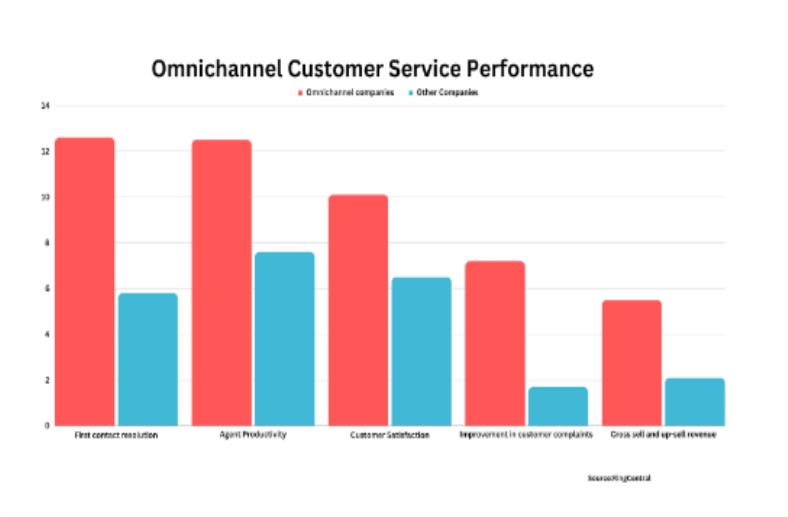These days, customers expect excellent shopping experiences whether online, on their phones, or in stores. To meet this expectation, brands must develop omnichannel strategies, ensuring seamless experiences across all shopping channels. This has become critical for great service, sales growth, happy customers, and a strong brand reputation.
Let’s see in this blog how omnichannel strategies connect websites, apps, and physical stores through technology. This sharing of inventory, transaction, and customer data enables consistent experiences across every channel.
I. Harnessing the Power of Omnichannel Strategies
An omnichannel approach involves connecting all customer interaction points with the company. This gives the customer a smooth and consistent experience. For instance, a shop might have a website, a mobile app, and physical stores, all integrated into a single, unified system.

The key idea behind an omnichannel approach is using technology to integrate all shopping channels into one consistent experience for customers. This experience works across devices and locations. Thus, regardless of how or where the customer interacts with the company, the experience remains smooth, cohesive, and tailored to the individual.
1. Integrating Customer Touchpoints
Seamless Transitions Between Channels
Companies need to make it easy for customers to go between things like websites, phone apps, stores, and customer service seamlessly. Using new technology tools behind the scenes, CCaaS companies can now connect these different “channels” to give customers a smooth, integrated experience as they shop across them.
For instance, sophisticated retail management systems and cloud software can synchronize customer information between online and physical stores. This allows things like
Easy returns or exchanges – buy something online, return in-store
Shared purchase history – Salespeople see your online browsing
Continuing transactions – fill cart on the app, check out on-site
So if you’re shopping on your phone, then go into the actual store, the employees have the same information to make your experience more connected. Or you can buy something online, and then return it through the store location near you. The technology links the website, app, and physical store.
Personalized Engagements
Integration also allows for personalized engagements based on channel-specific customer data. For example:
- Web browsing history enables targeted on-site recommendations
- In-store purchases facilitate customized email promos after checkout
- Service call insights can inform website chatbot conversations
Consistent Brand Messaging
Omnichannel integration requires presenting a consistent brand identity and tone of voice across all channels while allowing customization of formats.
2. Data-Driven Decision-Making
Comprehensive Customer Profiles
By aggregating data from all channels including sales transactions, web activity, service records, loyalty programs, and more, retailers can build unified customer profiles.
These reflect interests, purchase patterns, product affinities, contact preferences, and satisfaction levels across channels over time.
Predictive Analytics
In-depth analysis of channel-specific and cross-channel behavior enables predictive models. These powered by machine learning can:
- Forecast future purchase likelihood
- Recommend ideal products and messaging
- Calculate the customer’s lifetime value
- Estimate churn risks
This provides tailored omnichannel experiences.
Continuous Optimization
Tracking KPIs for customer acquisition, retention, conversions and engagement per channel feeds data-driven decisions to enhance weak touchpoints.
3. Consistency in Brand Messaging
Maintaining cohesive brand messaging across channels is vital, with 60% of millennials expecting uniform experiences online and offline (SDL). Tone, visual identity, promotions, policies, and even staff attitudes should align.
While adapting content formats to suit each channel is important, core values must remain intact. Inconsistency breeds confusion regarding brand ethos whereas consistency reinforces loyalty.
II. Overcoming Challenges in Omnichannel Implementation
Although omnichannel strategies offer significant business benefits, the integration of diverse solutions, alignment of various teams, and continuous staff training present substantial challenges.
1. Technology Integration
Complexities in Unifying Platforms
- Connecting legacy systems with modern cloud-based channels
- Enabling secure, timely data flows across touchpoints
- Scaling third-party integrations as new channels emerge
This grows exponentially complex as channels diversify, from mobile apps, websites, and IoT to upcoming metaverse worlds.
Emerging Retail Tech
Advanced tools like smart checkouts, interactive changing rooms, AR/VR solutions, blockchain ledgers, etc. impose additional integration efforts for full adoption. Their disruptive potential urgently necessitates omnichannel integration.
2. Organizational Alignment
Narrow Focus of Business Units
- Sales fixated on increasing basket values only
- Marketing chasing channel-siloed leads
- IT grappling with infra bandwidth issues
- Web team obsessed with on-site metrics
Need for Holistic KPIs
Setting KPIs tied to omnichannel goals is essential. These include:
- Customer retention rates
- Cross-channel conversion rates
- Lifetime value per customer
- Cost per acquisition across channels
Incentive programs for teams should align with these broader success indicators.
3. Training and Development
With rapid software and channel innovations, continuous omnichannel training for personnel is obligatory. Research reveals that companies investing in staff training average 24% higher profitability than those who neglect it, according to ATD.
Education programs, routine skill upgrades, and experiential simulations can empower teams to proficiently use new omnichannel tools for providing superior assistance. Agent training also promotes optimal customer interactions.
III. Measuring Success in Omnichannel Strategies
Once omnichannel plans are enacted, performance metrics become paramount for continual optimization.
1. Key Performance Indicators (KPIs)
Certain omnichannel retail KPIs are crucial for gauging success. They include channel-specific conversion rates, customer lifetime value per channel, and traffic sources. According to Google, businesses implementing omnichannel strategies experience an average increase of 80% in incremental store visits. This underscores the importance of tangible ROI metrics.
It’s crucial to attribute marketing-qualified leads to each channel. Sales numbers are divided by channel medium. It’s essential to analyze customer acquisition costs by channel. And omnichannel customer retention rates provide actionable data.
2. Customer Feedback and Satisfaction
Customer experience leaders outshine industry averages by nearly 80% on shareholder returns (Forrester). This proves that CX drives growth. Thus, it’s imperative to monitor omnichannel customer satisfaction through surveys, NPS ratings, and review analysis.
This provides qualitative insights into improving integrations and training. Feedback should be a solicited channel specifically as satisfaction metrics vary. Addressing concerns promptly also boosts omnichannel experiences.
3. Continual Improvement
Consumers use around 6 touch points per shopping journey. This number is bound to increase. According to Harvard Business Review, ongoing innovation is compulsory. Current channels should be continually refined while new channels get added to the ecosystem.
Evaluating the latest retail tech, rapidly deploying innovations at scale, and regularly retraining personnel facilitate continual progress. This is the omnichannel retail imperative today.
IV. Frequently Asked Questions
What data security measures can ensure privacy?
In early 2019, over 4 billion records were breached (RiskBased Security). Securing sensitive information is no longer optional. Encrypt data. Use tokenization. Adhere to GDPR standards. Restrict access. Test systems against threats. This helps.
How can experiences be personalized?
80% of customers are more likely to purchase when content is personalized (Epsilon). Behavioral monitoring, AI recommendations, and tailored messaging enable relevant customization at scale. They are based on purchase history and location data.
Can budget-constrained small businesses adopt omnichannel?
Absolutely. The cloud equalizes the playing field making sophisticated systems affordable for SMBs. Those embracing digital average 11% higher revenues than technology laggards (Deloitte). Modular SaaS platforms, mobile apps, virtual reality, and automation make implementing omnichannel easier than ever.
Conclusion
Companies should link websites, apps, and store data. This approach ensures that customers enjoy a consistent experience across all platforms. Their information and preferences are retained across all channels. This ensures a smooth shopping experience, whether online, via the app, or in-store. This convenience means more sales and happier long-term customers for those companies. Brands that integrate channels through technology will thrive in the future, as customers will increasingly expect a consistent experience wherever they shop.





